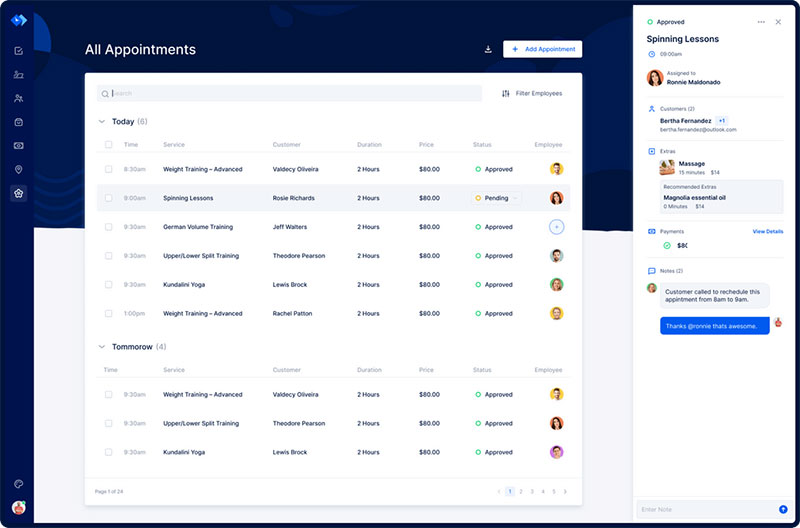The automation of business processes can be one of (if not the) most influential choices a company can make. It’s one of the factors that promote the exponential growth of organizations and gives them the tools to manage that growth.
This may seem like a stressful process. How can you automate business processes? Where should you start automating? Continue reading to find out more.
What Is Business Process Automation?
Business processes simply refer to the series of steps crucial to the completion of any business goals or tasks. The term can apply to employees working on tasks, customers taking part in your services, and even suppliers delivering products. The list goes on.
Business process automation refers to using technology to replace manual effort. Doing so not only reduces repetitive tasks, but also increases efficiency, minimizes costs, and streamlines processes.
That’s not all that business process automation can accomplish.
It also helps create more time for business collaboration, which can help your business meet its goals faster.
Keep in mind that business process automation is not business process management, although it can be similar. Business process management is often a more disciplined way of using methodologies and organization-wide processes to improve efficiency. Business process automation is much simpler because it’s only using technology to improve business operations.
The Benefits of Business Process Automation
Often the terms “business process automation” and “digital transformation” are used interchangeably. Although these two are similar, they are not the same. In general, business process automation refers to the process, while digital transformation is the destination.
The following are some of the benefits afforded to you when you automate business processes:
- Increased transparency and accountability. You will have a complete audit trail that will help you see who carried out which task.
- Faster turnaround times and a reduction in costs due to fewer manual interventions.
- Ability to monitor processes, find errors, and fix them on the fly.
- Increased security. Automated security control validation can help protect company data from being accessed or corrupted by unauthorized individuals.
- Developing an operating model that enables scaling. Models that are equipped to mold to your needs will increase efficiency and overall success.
- Improved efficiency. Automated processes are more efficient than manual tasks because they are more organized and streamlined.
- Reduced costs. Automation can save companies money by reducing the time required to carry out tasks.
Which Processes Can be Automated?
Administrative Work
Administrative work is one of the most important jobs that support core business operations. And, although it is important, usually a proficient system is all that’s required to complete the work.
This makes administrative work perfect for automation, and it can be connected to various regulatory systems to make it easier.
Purchase Orders
Purchase orders are usually recurring tasks consisting of teams filling out forms to send to purchasing teams.
These forms are then examined by an approving authority, but it is in general a simple process. The simplicity of the process makes automation a great option, especially for companies under time restraints.
Customer Service
Consider for a moment all the services or products your company offers. Managing customer service and customer satisfaction interactions can be a nightmare without the proper systems. If you are already using excel spreadsheets to manage your client’s requests, how often do you update them?
It can be especially difficult to update if you have multiple spreadsheets while employing multiple people to handle them. Instead, why not automate that process, and use those employees for something more useful? Implementing AI powered customer service can enhance this automation by providing responsive and adaptive interactions, significantly improving customer satisfaction and efficiency.
Employee Onboarding
Although it may seem to be a simple process, employee onboarding involves many tasks. Assigning mentors, filling out employee information forms, and arranging training sessions, just to name a few.
Why have your HR busy with all these tasks when you can use automation and increase overall operational efficiency?
Repetitive Work
All businesses have repetitive tasks. These tasks often don’t require special knowledge, skills, or human interaction, but they are often prone to error.
This combination creates the best opportunity for a robotic process automation system to shine. Whether it’s clerical work, data entry, or copy-paste inputs, automation can help.
Use a scheduling app to streamline your calendar
Staying organized has never been easier.
You can now manage your business and grow your brand with a single, powerful software that keeps all of your appointments in line, your clients organized and your business booming.
Trafft is perfect for business owners who need to streamline their booking experience both for their staff and their clients.
Trafft handles everything for you, even sending automated email or SMS reminders to your clients. No-shows? Not anymore!
The Trafft booking software adapts to different industries for a blissful online booking experience and employee management.
Want to know more? Check out Trafft’s awesome features to see what you are missing.
Steps in Automating a Business Process

Defining the Process
The first important step of automation is identifying what cannot be automated. This means finding which parts of the team need to be done by humans. You need to start with a set plan of what will be automated, who will automate it, and by when it should be completed.
You should also try to have clear goals for what the business automation solution should look like and the tasks it includes. Having a clear goal in mind will save time when fixing problems.
As an example, employee recruitment processes usually include tasks like
- Evaluating the application on the basis of hard skills and soft skills
- Interviewing the candidate (depending on how many interviews are needed)
- And notifying the candidate of their selection or rejection
Identify Functional Areas of Operations
Now that you have decided what cannot be automated, you can determine what should be automated. Perhaps this includes your customer service, sales teams, accounts payable, or inventory management. These are common choices, but don’t be afraid to innovate new automation ideas for complex business processes.
Collaboration is vital for this step. You will need to formulate viable solutions for the automated process that you chose, and this includes talking with your teams to find what needs solving. This is another place where defined goals can help.
Create SOPs
Standard Operating Procedures, or SOPs, document which steps are needed to complete the goals you set out. This is a crucial step when automating any process because automation teams need a defined list of actions and steps to complete the automation process.
While SOPs may sound great at first, often businesses place them in low priority. This often leads to missed deadlines and forgotten features. To keep on schedule, prioritize SOPs as quarterly goals within the entire company. This can help all employees find out what they have to do and when.
Calculate the Projected ROI of Automation
While it’s true that automation saves you time and money, it doesn’t come for free. It’s important to be mindful when comparing potential costs and the effort required when automating. This is why calculating the ROI of your automated processes is important, as the higher ROI activities should have priority over others.
Prioritize Areas to Automate
Business managers always have areas of improvement, but no one can fix everything all in one go. Prioritizing which areas of improvement need the most work will allow for progress without flipping the world on its head.
You may ask, what should I look for when prioritizing? Although ROI is very important, also think about the impact certain improvements will have on customers. Considering others’ feelings will make both your clients and customers happy.
Design Automation Systems for the Right People
Change is difficult for everyone, people often dread new software, fear new employees, or fear automation. This often correlates to a fear people have of the “point of no return”. People worry about losing their jobs or having more new things to learn, and the best way to counteract that fear is through preparation.
Try increasing awareness with your employees about these automation tools, and give them advance notice. Doing so will help employees use their automation tools to the best of their ability and calm their nerves.
Automate the Process Using A BPM Tool
Now that you know the process you want to automate, you have to find the right tool to automate it. There are many BPM tools available, so it is crucial to find the best one for what you need.
The first thing you should do is check the features. Ask yourself, does your company need all of them? Try to think of your automation processes as growth opportunities, so whichever tool you choose should be able to grow with your needs.
You can also choose to explore automation within your existing systems, especially if BPM software sounds unnecessary for your company. Project management software such as Trello, ClickUp, Basecamp, and Asana all have automated processes available that could fit your needs.
Monitoring and Optimizing the Process
Now that the process has been automated, it is very important to monitor the automation to be certain that it is running smoothly. This can easily be done using dashboards and reports, but you can also interact with the process directly to find results.
Results will not show up overnight, so prepare for a slow process Try measuring results with a phased approach, as this will lead to more consistent results.
Last of all, use that information. Optimize the process to improve efficiency and speed as much as possible. This means analyzing the information you found and innovating solutions to problems you find. For example, is a singular task too slow? Does the program require reorganizing? Is there a bottleneck forming, and if so, why is there a bottleneck? Discovering the problems is the first step in fixing them.
Study Security Risks of Automation
Hackers are a serious risk for everything online, and hackers often attack specifically when you automate business processes.
Implementing an information security operations center can help detect and mitigate cyber threats, ensuring your automated processes remain secure.
Try to plan ahead to protect yourself from hackers. You can do this by adding security to your automated processes or by taking extra precautions when protecting your data and credentials.
FAQs about automating business processes
1. What is business process automation (BPA) and how does it work?
Business process automation (BPA) is the term used to describe how manual or repetitive operations are streamlined and automated as part of a business process. Data entry, document routing, and approval procedures are a few examples of such tasks.
BPA often entails the use of software tools, including workflow management systems, to automate certain processes, thereby lowering the need for manual intervention and increasing productivity.
2. How can automation help businesses reduce costs and increase efficiency?
By removing the need for human work and lowering errors, automation can help organizations lower costs and boost efficiency. Businesses can free up time and resources to concentrate on more important initiatives by automating regular processes.
By eliminating the possibility of human error, which can result in expensive blunders, automation can also increase accuracy and consistency.
3. What types of business processes are best suited for automation?
Automation is often an excellent option for any repeatable, rule-based process. For instance, activities like data entry, invoice processing, and customer assistance can all be automated.
However, it’s important to keep in mind that not all processes can be automated, therefore it’s crucial to assess each process individually to decide whether automation is the best option.
4. What are some common challenges businesses face when implementing automation?
Businesses frequently encounter obstacles while deploying automation, such as opposition to change, a lack of knowledge or resources, and trouble connecting with current systems. When deploying automation, it’s critical to have a detailed plan in place that addresses these potential issues.
5. How can businesses ensure the security of their automated processes?
It is crucial to ensure the security of automated operations since, if improperly managed, automation can raise the danger of security breaches.
Secure sensitive data. This may entail putting access limits, encryption, and other security measures in place. Companies must make sure that all staff members are taught security best practices while using automated procedures.
6. What role does artificial intelligence (AI) play in automating business processes?
By enabling robots to learn from data and adapt based on it, artificial intelligence (AI) plays a significant role in automating business operations.
AI can be used to analyze data to find patterns or trends as well as to automate decision-making procedures like document routing or expense approval. Businesses can find chances for additional automation and optimization with the use of AI.
7. How can businesses measure the success of their automated processes?
Monitoring indicators such as time savings, error rates, and customer satisfaction can help determine how successful automated operations are. When introducing automation, it’s crucial to set up clear objectives and KPIs (key performance indicators) so that success can be accurately assessed.
8. What are some of the benefits of using robotic process automation (RPA) for business processes?
Software robots are used in robotic process automation (RPA), a type of automation, to automate monotonous operations. Many tasks, including as data entry, form filling, and customer service, can be automated using RPA. RPA offers advantages like increased productivity, lower costs, and better accuracy.
9. How can automation improve customer experience?
By accelerating operations, enhancing accuracy, and reducing response times, automation can enhance the customer experience.
For instance, automated customer assistance can answer inquiries from customers quickly and accurately, increasing customer happiness and lowering the demand for human involvement.
To make sure that the experience is satisfying and interesting, it’s crucial to make sure that automated processes are created with the client in mind.
10. What skills and expertise are needed to successfully implement automation in a business?
A variety of skills and knowledge are necessary for the successful implementation of automation in an organization, including project management, software development, and change management experience.
Understanding the business operations that will be automated, as well as the potential drawbacks and advantages of automation, is crucial.
Also, it’s critical to guarantee that there is ongoing assistance for the upkeep and improvement of automated processes and to have a plan in place for educating staff members on their use.
Will You Automate Business Processes?
All businesses have processes. They are vital! This means that automating your business processes can be the difference between a successful business and a failing business.
The truth is that when you automate business processes you find faster growth. So, identify those areas of operations, create those SOPs, focus on repetitive tasks, and prioritize the right areas to automate. You will not be disappointed.
Take a look at the leaders in the industry, those growing fast in particular, as examples. You can see the growth that comes with automation. These industry leaders often have dozens of automation projects, all of which lead to positive ROI. These examples lead to a simple outcome—automation is the future, and it is a bright one.
If you enjoyed reading this article about automated business processes, you should read these as well:
- The Many Types of Life Coaching Businesses You Can Start
- The Best Life Coaching Niches You Should Know About
- Social Media Marketing For Photographers: How To Do It Properly




